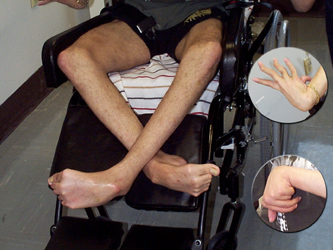Wilson's Disease
Vital youngsters who seem to be as athletic as any others begin to fail in skills. If one looks closely at
the eyes, within the usual eye color, a ring of copper color is seen in most cases. A certain step in secreting copper in liver cells goes amiss. The copper builds up and damages the liver. Transport of
spilled copper about the body goes wrong in that the usual transport protein does not get the proper access to the copper. Amino acids spill in the urine. The gene is recessive so it takes both parents as carriers in most cases.
Attempts to pull out the building copper from the liver by chelation have unfortunately resulted in the copper being dumped moreso in the brain - especially one region where associative movements are organized at a high level. The result is bizzarre rigid postures of extreme stiffness.
More recent drugs - especially based on zinc - have turned this disease around neurologically. Combinations of neuromuscular procedures with background drug treatment of the disease with these newer agents allows spectacular recoveries the likes of which are unmatched in any other disorder. The procedures used include nerve blocks of varied sorts, percutaneous muscle lengthenings, selective tendon releases and staged casts. Examples are shown in the section on percutaneous muscle lengthening (near the bottom).
 Here is one example. This teen aged fellow was an exceptional rock drummer before the onset of Wilson's
disease. In very rapid sequence coordination was lost. Neurologic damage was aggravated by penicillamine. At the time of this photo, treatment had been swapped to the newer agents and progression was arrested but
losses not reversed.
Here is one example. This teen aged fellow was an exceptional rock drummer before the onset of Wilson's
disease. In very rapid sequence coordination was lost. Neurologic damage was aggravated by penicillamine. At the time of this photo, treatment had been swapped to the newer agents and progression was arrested but
losses not reversed.
He could not hold objects, let alone drum. Sitting was difficult, standing and walking impossible.
A series of targeted treatments which include transient nerve blocks and casts with surgical muscle lengthening and transfers was followed by targeted bone procedures after the motion aspects were approximated.
computer=>
|
The ATP7B gene is abnormal. It's behavior is modified by another known gene (PRNP). How the gene is abnormal (one amino acid vs another) affects how long it takes to become clinically manifest.
Penicillamine (Cuprimine) caused serious side effects including
neurological symptoms and birth defects as copper was pulled from liver but spilled to brain. It was the only treatment at one time. It interferes with vitamin B6, another source of trouble.
Trientine (Syprine) attaches to copper as well as iron and assists getting those elements out of the body. Iron supplements interfere.
Zinc acetate, by merely blocking zinc intake, is slow, but OK for pregnant women.
Tetrathiomolybdate. Another copper-binder now being tested.
Copper rich foods: peas, beans, lentils, liver, shellfish, tap water (varies), bran, avocado, chocolate, dried fruit, nuts, mushrooms...
